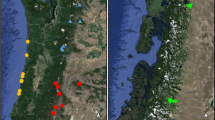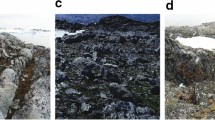Abstract
This paper examines the hypothesis that non-native plant invasions are related to fluctuating resource availability as proposed by Davis et al. (2000). I measured relative functional responses of both invasive and native plants to changed resource availability due to nutrient enrichment and rainfall, and to increased disturbance. Data are presented from studies in two contrasting ecosystems. First is a series of glasshouse and field experiments on the invader Hieracium lepidulum and associated invasive and native species in subalpine temperate New Zealand. Second is a field study of invasive and native plant responses to altered disturbance regimes and rainfall from tropical savannas of north eastern Australia. Invaders responded differently from native species to changes in resource availability in both subalpine and tropical studies. However, invaders differed among themselves showing that different species exploit different functional niches to invade their respective habitats. These findings contribute to the contention that the fluctuating resource hypothesis does not provide a universal explanation for plant invasions. The diverse functional responses to increased resource availability among invaders in this and previous studies suggest that the cause of invasion depends on unique combinations of habitat and functional attributes of invaders and native assemblages. Such findings imply that universal predictions of what will happen under climate change scenarios across the globe will be difficult to make.
Similar content being viewed by others
References
Ash A J, Princen J H, Myles D J, et al. 1982. Short-term effects of burning native pasture in spring on herbage and animal production in south-east Queensland. Proceedings for the Australian Society of Animal Production.
Ash A J, McIvor J G, Mott J J, et al. 1997. Building grass castles: Integrating ecology and management of Australia’s tropical tallgrass rangelands. Rangeland Journal, 19: 123–144.
Ash A J, McIvor J G. 1998. How season of grazing and herbivore selectivity influence monsoon tall-grass communities of northern Australia. Journal of Vegetation Science, 9: 123–132.
Baker H G. 1965. Characteristics and modes of origin of weeds. In: Baker H G, Stebbins G L. The Genetics of Colonising Species. New York: Academic Press, 147–172.
Burke M J W, Grime J P. 1996. An experimental study of plant community invasibility. Ecology, 77: 776–790.
Caccianiga M, Luzzaro A, Pierce S, et al. 2006. The functional basis of a primary succession resolved by CSR classification. Oikos, 112: 10–20.
Daehler C. 2003. Performance comparisons of co-occurring native and alien invasive plants: implications for conservation and restoration. Annual Review of Ecology and Systematics, 34: 183–211.
Davis M A, Grime P J, Thompson K. 2000. Fluctuating resources in plant communities: a general theory of invasibility. Journal of Ecology, 88: 528–534.
Downs T M, Radford I J. 2005. Arbuscular mycorrhizal fungal colonization of Hieracium lepidulum roots in experimental and field soil inoculated media. New Zealand Journal of Botany, 43: 843–850.
Fuhlendorf S D, Harrell W C, Engle D M, et al. 2006. Should heterogeneity be the basis for conservation? Grassland bird response to fire and grazing. Ecological Applications, 16: 1706–1716.
Funk J L, Vitousek P M. 2007. Resource-use efficiency and plant invasion in low-resource systems. Nature, 446: 1079–1081.
Garnier E. 1998. Interspecific variation in plasticity of grasses in response to nitrogen supply. In: Cheplick G P. Population Biology of Grasses. Cambridge: Cambridge University Press.
Grice A C. 1996. Seed production, dispersal and germination in Cryptostegia grandiflora and Ziziphus mauritiana, two invasive shrubs in tropical woodlands of northern Australia. Australian Journal of Ecology, 21: 324–331.
Grice A C. 1997. Post-fire regrowth and survival of the invasive tropical shrubs Cryptostegia grandiflora and Ziziphus mauritiana. Australian Journal of Ecology, 22: 49–55.
Grime J P, Hodgson J, Hunt R. 1988. Comparative Plant Ecology. A Functional Approach to Common British Species. London: Unwin Hyman.
Grime J P, Thompson K, Hunt R, et al. 1997. Integrated screening validates primary axes of specialisation in plants. Oikos, 79: 259–281.
Hierro J L, Maron J L, Callaway R M. 2005. A biogeographical approach to plant invasions: the importance of studying exotics in their introduced and native range. Journal of Ecology, 93: 5–15.
Hobbs R J, Atkins L. 2006. Effect of disturbance and nutrient addition on native and introduced annuals in plant communities in the Western Australian wheatbelt. Austral Ecology, 13: 171–179.
Hodgson J G, Wilson P J, Hunt R, et al. 1999. Allocating C-S-R plant functional types: a soft approach to a hard problem. Oikos, 85: 282–294.
Holmgren M, Aviles R, Sierrialta L, et al. 2000. Why have European herbs so successfully invaded the Chilean matorral? Effects of herbivory, soil nutrients, and fire. Journal of Arid Environments, 44: 197–211.
Hulme P E, Barrett C H. 2012. Integrating trait- and niche-based approaches to assess contemporary evolution in alien plant species. Journal of Ecology, doi: 10.1111/1365-2745.12009.
Huston M A. 2004. Management strategies for plant invasions: manipulating productivity, disturbance, and competition. Diversity and Distributions, 10: 167–178.
Jabot F, Pottier J. 2012. A general modelling framework for resource-ratio and CSR theories of plant community dynamics. Journal of Ecology 100: 1296–1302.
Keddy P A, Nielsen K, Weiher E, et al. 2002. Relative competitive performance of 63 species of terrestrial herbaceous plants. Journal of Vegetation Science, 13: 5–16.
Lambdon P W, Lloret F, Hulme P E. 2008. Do alien plants on Mediterranean islands tend to invade different niches from native species? Biological Invasions, 10: 703–716.
Lonsdale W M. 1999. Global patterns of plant invasions and the concept of invisibility. Ecology, 80: 1522–1536.
McIvor J G. 2006. Pasture management in semi-arid tropical woodlands: Effects on species diversity. Austral Ecology, 23: 349–364.
Milchunas D G, Lauenroth W K. 1995. Inertia in plant community structure: State changes after cessation of nutrient-enrichment stress. Ecological Applications, 5: 452–458.
Moles A T, Flores-Mareno H, Bosner S P, et al. 2012. Invasions: the trail behind, the path ahead, and a test of a disturbing idea. Journal of Ecology, 100: 116–127.
Perkins L B, Leger E A, Nowak R S. 2011. Invasion triangle: an organizational framework for species invasion. Ecology and Evolution, 1: 610–625.
Perrins J, Fitter A, Williamson M. 1993. Population biology and rates of invasion of three introduced Impatiens species in the British Isles. Journal of Biogeography, 20: 33–44.
Pierce S, Luzzaro A, Caccianiga M, et al. 2007. Disturbance is a principal α-scale filter determining niche differentiation, coexistence and biodiversity in an alpine community. Journal of Ecology, 95: 698–706.
Quiroz C L, Cavieres L A, Pauchard A. 2011. Assessing the importance of disturbance, site conditions, and the biotic barrier for dandelion invasion in an alpine habitat. Biological Invasions, 13: 2889–2899.
Radford I J, Cousens R D. 2000. Invasiveness and comparative life-history traits of exotic and indigenous Senecio species in Australia. Oecologia, 125: 531–542.
Radford I J, Dickinson K J M, Lord J M. 2006. Nutrient stress and performance of invasive Hieracium lepidulum and co-occurring species in New Zealand. Basic and Applied Ecology, 7: 320–333.
Radford I J, Dickinson K J M, Lord J M. 2007. Functional and performance comparisons of invasive Hieracium lepidulum and co-occurring species in New Zealand. Austral Ecology, 32: 338–354.
Radford I J, Grice A C, Abbott B N, et al. 2008. Impacts of wet and dry season prescribed burning on invasive Cryptostegia grandiflora populations and on associated tropical woodland, and riparian forest in north Queensland, Australia. Austral Ecology, 33: 151–167.
Radford I J, Dickinson K J M, Lord J M. 2009. Does the invader Hieracium lepidulum have a comparative growth advantage over co-occurring plants? High leaf area and low metabolic costs as invasive traits. New Zealand Journal of Botany, 47: 395–403.
Radford I J, Dickinson K J M, Lord J M. 2010. Does disturbance, competition or resource limitation underlie Hieracium lepidulum invasion in New Zealand? Mechanisms of establishment and persistence, and functional differentiation among invasive and native species. Austral Ecology, 35: 282–293.
Rejmanek M, Richardson D M. 1996. What attributes make some plant species more invasive? Oecologia, 77: 1655–1661.
Richardson D M, Pysek P. 2012. Naturalization of introduced plants: ecological drivers of biogeographical patterns. New Phytologist, doi: 10.1111/j.1469-8137.2012.04292.x
Roberts A, Radford I J, Orlovich D A. 2009. Do alterations of arbuscular mycorrhizal fungal communities change interactions between an invader Hieracium lepidulum and two co-occurring species? A glasshouse study. Australasian Mycologist, 28: 29–35.
Thompson K, Hodgson J G, Grime J P, et al. 2001. Plant traits and temporal scale: evidence from a 5-year invasion experiment using native species. Journal of Ecology, 89: 1054–1060.
Thomson V P, Leishman M R. 2005. Post-fire vegetation dynamics in nutrient enriched and non-enriched sclerophyll woodland. Austral Ecology, 30: 250–260.
Vila M, Weiner J. 2004. Are invasive plant species better competitors than native plant species? Evidence from pair-wise experiments. Oikos, 105: 229–238.
Vila M, Williamson M, Lonsdale M. 2004. Competition experiments on alien weeds with crops: lessons for measuring plant invasion impact? Biological Invasions, 6: 59–69.
Williams R J, Gill A M, Moore P H R. 1998. Seasonal changes in fire behaviour in a tropical savanna in northern Australia. International Journal of Wildland Fire, 8: 227–239.
Winter W H 1987. Using fire and supplementation to improve cattle production from monsoon tallgrass pastures. Tropical Grasslands, 21: 71–80.
Author information
Authors and Affiliations
Corresponding author
Rights and permissions
About this article
Cite this article
Radford, I.J. Fluctuating resources, disturbance and plant strategies: diverse mechanisms underlying plant invasions. J. Arid Land 5, 284–297 (2013). https://doi.org/10.1007/s40333-013-0164-0
Received:
Revised:
Accepted:
Published:
Issue Date:
DOI: https://doi.org/10.1007/s40333-013-0164-0




